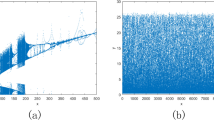Abstract
This paper proposes a new digital communication scheme, which uses chaotic signals based on the adaptive synchronization and parameter identification technique of chaotic systems reported recently. Due to the multi signal character, this scheme combines the chaotic signal transmission with the MIMO channel technique in a wireless environment, which is different from the traditional chaotic communication frameworks. From a practical perspective, an outline of modulation, channel model, demodulation and non-coherent detection is investigated. Furthermore, system performance is evaluated by simulations, and improvements on this scheme are also discussed.
Similar content being viewed by others
References
Kolumban, G, Kennedy M P, Chua L O. The role of synchronization in digital communications using chaos. I. Fundamentals of digital communications. IEEE Trans Circuits Syst I Fundam Theory Appl, 1997, 44: 927–936
Pecora L M, Carroll T L. Synchronization in chaotic systems. Phys Rev Lett, 1990, 64: 821–824
Kennedy MP, Dedieu H. Experimental demonstration of binary chaos-shift-keying using self-synchronising chua's circuits. In: Proceedings of the International Workshop Nonlinear Dynamics in Electronic Systems, Dresden, 1993. 67–72
Kolumban G, Vizvari B, Schwarz W, et al. Differential chaos shift keying: A robust coding for chaotic communication. In: Proceedings of International Workshop Nonlinear Dynamics in Electronic Systems, Seville, 1996. 87–92
Kolumban G, Kennedy M P, Kis G. Performance improvement of chaotic communications systems. In: Proceedings of European Conference on Circuit Theory and Design, Budapest, 1997. 284–289
Halle K S, Wu C W, Itoh M, et al. Spread spectrum communication through modulation of chaos. Int J Bifurcation Chaos, 1993, 3: 469–477
Parlitz U, Chua L O, Kocarev L, et al. Transmission of digital signals by chaotic synchronization. Int J Bifurcation Chaos, 1992, 2: 973–977
Abel A, Schwarz W. Chaos communications-principles, schemes, and system analysis. Proc IEEE, 2002, 90: 691–710
Mazzini G, Rovatti R, Setti G. Interference minimisation by autocorrelation shaping in asynchronous DS-CDMA systems: chaos-based spreading is nearly optimal. Electron Lett, 1999, 35: 1054–1055
Wang J, Milstein L B. CDMA overlay situations for microcellular mobile communications. IEEE Trans Commun, 1995, 43: 603–614
Wang J, Chen J. Performance of wideband CDMA systems with complex spreading and imperfect channel estimation. IEEE J Sel Areas Commun, 2002, 19: 152–163
Chen G R, Yu X H. Chaos Control: Theory and Applications. New York: Springer-Verlag, 2003
Kolumban G, Kennedy M P, Chua L O. The role of synchronization in digital communications using chaos. II. Chaotic modulation and chaotic synchronization. IEEE Trans Circuits Syst I Fundam Theory Appl, 1998, 45: 1129–1140
Kolumban G, Kennedy M P. Communications using chaos. III. Performance bounds for correlation receivers. IEEE Trans Circuits Syst I Fundam Theory Appl, 2000, 47: 1673–1683
Carroll T L. Chaotic systems that are robust to added noise. Chaos An Interdisciplinary J Nonlinear Sci, 2005, 15: 013901
Xia Y X, Tse C K, Lau F C M. Performance of differential chaos-shift-keying digital communication systems over a multipath fading channel with delay spread. IEEE Trans Circuits Syst II Exp Briefs, 2004, 51: 680–684
Lin W, Ma H F. Failure of parameter identification based on adaptive synchronization techniques. Phys Rev E, 2007, 75: 066212
Lin W. Adaptive chaos control and synchronization in only locally Lipschitz systems. Phys Lett A, 2008, 372: 3195–3200
Jafarkhani H. Space-time Coding: Theory and Practice. Cambridge: Academic, 2005
Collins B S. Polarization-diversity antennas for compact base stations. Microwave J, 2000, 43: 76–88
Nabar R U, Bolcskei H, Erceg V, et al. Performance of multiantenna signaling techniques in the presence of polarization diversity. IEEE Trans Signal Process, 2002, 50: 2553–2562
Lin W, He Y B. Complete synchronization of the noise-perturbed Chua's circuits. Chaos An Interdisciplinary J Nonlinear Sci, 2005, 15: 023705
Author information
Authors and Affiliations
Corresponding author
Rights and permissions
About this article
Cite this article
Ma, H., Kan, H. A new scheme of digital communication using chaotic signals in MIMO channels. Sci. China Inf. Sci. 55, 2183–2193 (2012). https://doi.org/10.1007/s11432-011-4352-2
Received:
Accepted:
Published:
Issue Date:
DOI: https://doi.org/10.1007/s11432-011-4352-2




